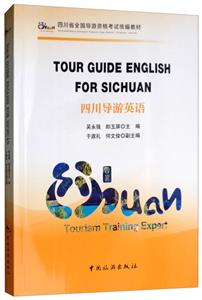-
>
蔡澜作品: 三乐也
-
>
探路者丛书:宇宙探索
-
>
一听说那岛上有猫,我就出发了:日本猫岛旅行笔记
-
>
中国分省系列地图册:江苏(2016年全新版)
-
>
珍藏巴黎
-
>
诗情画意山东游(全17册)
-
>
(平)徐霞客游记
四川导游英语 版权信息
- ISBN:9787503260582
- 条形码:9787503260582 ; 978-7-5032-6058-2
- 装帧:一般胶版纸
- 册数:暂无
- 重量:暂无
- 所属分类:>
四川导游英语 内容简介
《四川导游英语》既是四川英语导游人员资格考试的培训教材,又是四川英语导游、领队、外事工作者等专业人士的工作用书,也可作为四川省高等院校游管理专业的导游英语教材、旅游英语教材和英语专业旅游英语方向的相关教材。 同时,《四川省全国导游资格考试统编教材:四川导游英语》也是外国游客来四川旅游非常实用的随身参考书。 《四川省全国导游资格考试统编教材:四川导游英语》分为三个部分:四川社会与文化、四川著名景点和导游带团技巧。**部分社会与文化主要介绍了四川的历史文化、社会概况、餐饮文化等内容,具体包括四川、成都、川菜、川茶、川酒、川剧、四川的手工艺品以及四川的少数民族共八章。本部分不仅是《四川省全国导游资格考试统编教材:四川导游英语》的重要内容和显著特点,也是导游英文讲解中的难点和重点。第二部分四川著名景点选取了四川具代表性的人文景观和自然景区加以介绍,包括5处世界遗产:都江堰一青城山、峨眉山一乐山大佛、九寨沟、黄龙寺、四川大熊猫栖息地;4个著名博物馆:武侯祠、杜甫草堂、金沙以及三星堆。第三部分导游带团技巧主要举例说明了英语导游在带团过程中所需的各种技能,如致欢迎词与欢送词、途中导游、讲解方法、紧急情况的处理等,目的在于提高英语导游的实际工作技能与讲解水平。
四川导游英语 目录
Chapter 1 An Introduction to Sichuan Province
Chapter 2 Chengdu-Capital of Sichuan Province
Chapter 3 Sichuan Cuisine
Chapter 4 Sichuan Tea
Chapter 5 Sichuan Liquor
Chapter 6 Sichuan Opera
Chapter 7 Ethnic Groups in Sichuan Province
Chapter 8 Arts and Crafts in Sichuan
Part 2 Some Select Scenic Spots in Sichuan Province
Chapter 1 Wuhou Shrine
Chapter 2 Du Fu's Thatched Cottage
Chapter 3 Jinsha Ruins
Chapter 4 Sanxingdui Museum
Chapter 5 Mt. Qingcheng
Chapter 6 Dujiangyan Irrigation Project
Chapter 7 Leshan Giant Buddha
Chapter 8 Mt. Emei
Chapter 9 Wolong Giant Panda Nature Reserve
Chapter 10 Jiuzhaigou Valley
Chapter 11 Huanglong Valley
Part 3 Professional Skills in Tour Guiding'
Chapter 1 Speeches by the Tour Guide
Chapter 2 On-the-Way Tour
Chapter 3 Basic Methods of lnterpretation for Tour Guiding
Chapter 4 Handling Emergency Cases
Chapter 5 Words and Commonly-used Sentences for Tour Guiding
Appendix
References
四川导游英语 节选
《四川省全国导游资格考试统编教材:四川导游英语》: China has always been acclaimed as the homeland of tea. It is believed that teashrubs was found growing in what is now China about five to six thousand years ago, and cultivation of teaplants has a history of two thousand years. Tea from Cluna, along with silk and porcelain, began to be known to the world more than a thousand years ago and has since been an important Cl:unese commodity for export. The antioxidant functions of tea have made it more and more popular in an increasing-health-awareness world. These health facilitating functions partially benefit from the geological conditions in which tea shrubs or tea trees grow. As is recorded in Hua Tuo Shi Lun (Hua Tuo, died AD 121) (Eating Scriptures), "Tea trees grow in the river valleys and mountain slopes of Yizhou (an ancient prefecture including what is now Sichuan and Yunnan regions), and the tea tree leaves are oflen plucked on the third day of the Lunar March." Now it is well known that the tea plant grows best in tropical and temperate places where there is rainfall throughout the year. Tea trees can grow at an altitude of about 2,000 meters, and the higher the region, the better the tea quality is. With increasing awareness of health functions of drinking tea, more sophisticated rituals of tea drinking have also been incorporated to indicate social status and privileges enjoyed by elites. In the Song Dynasty, emperors brewed tea to entertain their favorite ministers and scholars, wrote poems about tea and made tea drinking an indispensable part of their intellectual life, While tea sets have become more delicate and elaborated and tea drinking has been endowed with more culture significance, tea quality and the water to brew tea remains essential for tea drinking. And that can fully explain why tea produced in Sichuan was taken to court as Tribute Tea and why there has existed the saying in Sichuan, "the water in the Yangtze River is the best for-brewing tea from Mt. Mengding". 1. Tea cultivation in Sichuan Sichuan is one of the first regions where tea trees were cultivated. The best known and also the most typical of tea growing regions in Sichuan is Mt. Mengding. The mountain is located fifteen miles west of Mingshan County《四川省全国导游资格考试统编教材:四川导游英语》 (名山县) , with five crests taking the shape of a lotus. On the highest one are seven tea trees which, as the legend goes, were planted by Wu Lizhen (吴理真) , an herb farmer, at the end of the Western Han Dynasty (206 BC-AD 25). In the Mengshan County Annals you will find the following record: "These seven tea trees neither withered nor thrived throughout two thousand years. The leaves are slender and long, tasting distinctively sweet. When brewed, the infusions produce the color somewhere between yellow and green, and the steam, saturated with scents of tea, hovers for quite some time." These seven tea trees are surrounded by stone fences built in the Tang Dynasty and are known as the Imperial Tea Garden. In the first year of the Tianbao Era of the Tang Dynasty, Mengding Tea (tea produced in Mt. Mengding region) was listed as Gong Cha (Tribute Tea) to serve the imperial court. This practice had been kept until the Qing Dynasty, lasting almost a thousand years. Back then, three hundred and sixty leaves would be plucked from these seven tea trees each year for the emperor to use in the sacrificing ceremony.to Heaven and to the Imperial Ancestral Temple. These tea leaves were called "Tribute Tea". Tea for emperors to brew to entertain themselves was "Deputy Tribute Tea", and tea for ministers was given the name of "Escorting Tribute Tea". ……
- >
有舍有得是人生
有舍有得是人生
¥19.4¥45.0 - >
罗庸西南联大授课录
罗庸西南联大授课录
¥13.8¥32.0 - >
月亮虎
月亮虎
¥17.8¥48.0 - >
莉莉和章鱼
莉莉和章鱼
¥18.1¥42.0 - >
我从未如此眷恋人间
我从未如此眷恋人间
¥16.4¥49.8 - >
名家带你读鲁迅:朝花夕拾
名家带你读鲁迅:朝花夕拾
¥10.5¥21.0 - >
唐代进士录
唐代进士录
¥19.1¥39.8 - >
伊索寓言-世界文学名著典藏-全译本
伊索寓言-世界文学名著典藏-全译本
¥6.1¥19.0
-
厦门导游词
¥5.4¥16 -
天坛导游手册
¥3.5¥10 -
精编甘肃导游词:甘肃案内:日汉对照
¥6.4¥20 -
导游与中国文化
¥10.9¥32 -
2022图书×抽奖盲袋
¥9.9¥25 -
2023读书月阅读盲盒——天黑,闭眼,刀谁?
¥42.3¥158
















